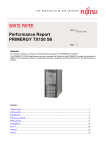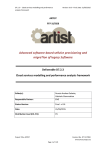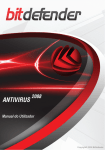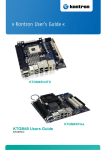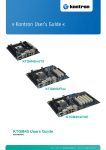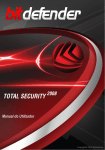Download VMware 4 Computer Accessories User Manual
Transcript
WHITE VMware vSphere™ 4 Fault Tolerance: Architecture and Performance PAPER VMware white paper Table of Contents 1. VMware Fault Tolerance Architecture . . . . . . . . . . . . . . . . . . . . . . . . . . . . . . . . . . . . . . . . . . 3 1.1. Deterministic Record/Replay . . . . . . . . . . . . . . . . . . . . . . . . . . . . . . . . . . . . . . . . . . . . . . . . . . . . . . . . . . . . . . . . . . . . 1.2. Fault Tolerance . . . . . . . . . . . . . . . . . . . . . . . . . . . . . . . . . . . . . . . . . . . . . . . . . . . . . . . . . . . . . . . . . . . . . . . . . . . . . . . . . 1.3. VMware vLockstep Interval . . . . . . . . . . . . . . . . . . . . . . . . . . . . . . . . . . . . . . . . . . . . . . . . . . . . . . . . . . . . . . . . . . . . . 1.4. Transparent Failover . . . . . . . . . . . . . . . . . . . . . . . . . . . . . . . . . . . . . . . . . . . . . . . . . . . . . . . . . . . . . . . . . . . . . . . . . . . . 3 3 4 4 2. Performance Aspects and Best Practice Recommendations . . . . . . . . . . . . . . . . . . . . . 5 2.1. FT Operations: Turning On and Enabling . . . . . . . . . . . . . . . . . . . . . . . . . . . . . . . . . . . . . . . . . . . . . . . . . . . . . . . . 2.2. Resource Consumption . . . . . . . . . . . . . . . . . . . . . . . . . . . . . . . . . . . . . . . . . . . . . . . . . . . . . . . . . . . . . . . . . . . . . . . . . 2.3. Secondary Virtual Machine Execution Speed . . . . . . . . . . . . . . . . . . . . . . . . . . . . . . . . . . . . . . . . . . . . . . . . . . . . 2.4. I/O Latencies . . . . . . . . . . . . . . . . . . . . . . . . . . . . . . . . . . . . . . . . . . . . . . . . . . . . . . . . . . . . . . . . . . . . . . . . . . . . . . . . . . . 2.5. Network Link . . . . . . . . . . . . . . . . . . . . . . . . . . . . . . . . . . . . . . . . . . . . . . . . . . . . . . . . . . . . . . . . . . . . . . . . . . . . . . . . . . . 2.6. NIC Assignments for Logging Traffic . . . . . . . . . . . . . . . . . . . . . . . . . . . . . . . . . . . . . . . . . . . . . . . . . . . . . . . . . . . . . 2.7. Virtual Machine Placement . . . . . . . . . . . . . . . . . . . . . . . . . . . . . . . . . . . . . . . . . . . . . . . . . . . . . . . . . . . . . . . . . . . . . 2.8. DRS and VMotion . . . . . . . . . . . . . . . . . . . . . . . . . . . . . . . . . . . . . . . . . . . . . . . . . . . . . . . . . . . . . . . . . . . . . . . . . . . . . . . 2.9. Timer Interrupts . . . . . . . . . . . . . . . . . . . . . . . . . . . . . . . . . . . . . . . . . . . . . . . . . . . . . . . . . . . . . . . . . . . . . . . . . . . . . . . . 2.10. Fault Tolerance Logging Bandwidth Sizing Guideline . . . . . . . . . . . . . . . . . . . . . . . . . . . . . . . . . . . . . . . . . . . 5 5 5 6 6 6 6 7 7 7 3. Fault Tolerance Performance . . . . . . . . . . . . . . . . . . . . . . . . . . . . . . . . . . . . . . . . . . . . . . . . . . 7 3.1. SPECjbb2005 . . . . . . . . . . . . . . . . . . . . . . . . . . . . . . . . . . . . . . . . . . . . . . . . . . . . . . . . . . . . . . . . . . . . . . . . . . . . . . . . . . . 7 3.2. Kernel Compile . . . . . . . . . . . . . . . . . . . . . . . . . . . . . . . . . . . . . . . . . . . . . . . . . . . . . . . . . . . . . . . . . . . . . . . . . . . . . . . . . 8 3.3. Netperf Throughput . . . . . . . . . . . . . . . . . . . . . . . . . . . . . . . . . . . . . . . . . . . . . . . . . . . . . . . . . . . . . . . . . . . . . . . . . . . . 9 3.4. Netperf Latency Bound Case . . . . . . . . . . . . . . . . . . . . . . . . . . . . . . . . . . . . . . . . . . . . . . . . . . . . . . . . . . . . . . . . . . . . 9 3.5. Filebench Random Disk Read/Write . . . . . . . . . . . . . . . . . . . . . . . . . . . . . . . . . . . . . . . . . . . . . . . . . . . . . . . . . . . . 10 3.6. Oracle 11g . . . . . . . . . . . . . . . . . . . . . . . . . . . . . . . . . . . . . . . . . . . . . . . . . . . . . . . . . . . . . . . . . . . . . . . . . . . . . . . . . . . . 11 3.7. Microsoft SQL Server 2005 . . . . . . . . . . . . . . . . . . . . . . . . . . . . . . . . . . . . . . . . . . . . . . . . . . . . . . . . . . . . . . . . . . . . . 12 3.8. Microsoft Exchange Server 2007 . . . . . . . . . . . . . . . . . . . . . . . . . . . . . . . . . . . . . . . . . . . . . . . . . . . . . . . . . . . . . . . 13 4. VMware Fault Tolerance Performance Summary . . . . . . . . . . . . . . . . . . . . . . . . . . . . . . . 14 5. Conclusion . . . . . . . . . . . . . . . . . . . . . . . . . . . . . . . . . . . . . . . . . . . . . . . . . . . . . . . . . . . . . . . . . . 14 Appendix A: Benchmark Setup . . . . . . . . . . . . . . . . . . . . . . . . . . . . . . . . . . . . . . . . . . . . . . . . . 15 Storage Array . . . . . . . . . . . . . . . . . . . . . . . . . . . . . . . . . . . . . . . . . . . . . . . . . . . . . . . . . . . . . . . . . . . . . . . . . . . . . . . . . . . . . 15 Primary and Secondary Hosts . . . . . . . . . . . . . . . . . . . . . . . . . . . . . . . . . . . . . . . . . . . . . . . . . . . . . . . . . . . . . . . . . . . . . . 15 Client Machine . . . . . . . . . . . . . . . . . . . . . . . . . . . . . . . . . . . . . . . . . . . . . . . . . . . . . . . . . . . . . . . . . . . . . . . . . . . . . . . . . . . . 15 Appendix B: Workload Details . . . . . . . . . . . . . . . . . . . . . . . . . . . . . . . . . . . . . . . . . . . . . . . . . . 16 SPECjbb2005 . . . . . . . . . . . . . . . . . . . . . . . . . . . . . . . . . . . . . . . . . . . . . . . . . . . . . . . . . . . . . . . . . . . . . . . . . . . . . . . . . . . . . . 16 Kernel Compile . . . . . . . . . . . . . . . . . . . . . . . . . . . . . . . . . . . . . . . . . . . . . . . . . . . . . . . . . . . . . . . . . . . . . . . . . . . . . . . . . . . . 16 Netperf . . . . . . . . . . . . . . . . . . . . . . . . . . . . . . . . . . . . . . . . . . . . . . . . . . . . . . . . . . . . . . . . . . . . . . . . . . . . . . . . . . . . . . . . . . . 16 Filebench . . . . . . . . . . . . . . . . . . . . . . . . . . . . . . . . . . . . . . . . . . . . . . . . . . . . . . . . . . . . . . . . . . . . . . . . . . . . . . . . . . . . . . . . . 16 Oracle 11g — Swingbench . . . . . . . . . . . . . . . . . . . . . . . . . . . . . . . . . . . . . . . . . . . . . . . . . . . . . . . . . . . . . . . . . . . . . . . . 16 MSSQL 2005 — DVD Store Benchmark . . . . . . . . . . . . . . . . . . . . . . . . . . . . . . . . . . . . . . . . . . . . . . . . . . . . . . . . . . . . . 17 Exchange 2007 — Loadgen . . . . . . . . . . . . . . . . . . . . . . . . . . . . . . . . . . . . . . . . . . . . . . . . . . . . . . . . . . . . . . . . . . . . . . . . 18 2 VMware white paper VMware® Fault Tolerance (FT) provides continuous availability to virtual machines, eliminating downtime and disruption — even in the event of a complete host failure. This whitepaper gives a brief description of the VMware FT architecture and discusses the performance implication of this feature with data from a wide variety of workloads. 1. VMware Fault Tolerance Architecture The technology behind VMware Fault Tolerance is called VMware® vLockstep. The following sections describe some of the key aspects of VMware vLockstep technology. 1.1. Deterministic Record/Replay Deterministic Record/Replay is a technology introduced with VMware Workstation 6.0 that allows for capturing the execution of a running virtual machine for later replay. Deterministic replay of computer execution is challenging since external inputs like incoming network packets, mouse, keyboard, and disk I/O completion events operate asynchronously and trigger interrupts that alter the code execution path. Deterministic replay could be achieved by recording non-deterministic inputs and then by injecting those inputs at the same execution point during replay (see Figure 1). This method greatly reduces processing resources and space as compared to exhaustively recording and replaying individual instructions. Figure 1. Event Injection during Replay Disk I/O Timer Event In order to efficiently inject the inputs at the correct execution point, some processor changes were required. VMware collaborated with AMD and Intel to make sure all currently shipping Intel and AMD server processors support these changes. See KB article 1008027 for a list of supported processors. VMware currently supports record/replay only for uniprocessor virtual machines. Record/Replay of symmetric multi-processing (SMP) virtual machines is more challenging because in addition to recording all external inputs, the order of shared memory access also has to be captured for deterministic replay. 1.2. Fault Tolerance Logging Traffic Figure 2 shows the high level architecture of VMware Fault Tolerance. VMware FT relies on deterministic record/replay technology described above. When VMware FT is enabled for a virtual machine (“the primary”), a second instance of the virtual machine (the “secondary”) is created by live-migrating the memory contents of the primary using VMware® VMotion™. Once live, the secondary virtual machine runs in lockstep and effectively mirrors the guest instruction execution of the primary. The hypervisor running on the primary host captures external inputs to the virtual machine and transfers them asynchronously to the secondary host. The hypervisor running on the secondary host receives these inputs and injects them into the replaying virtual machine at the appropriate execution point. The primary and the secondary virtual machines share the same virtual disk on shared storage, but all I/O operations are performed only on the primary host. While the hypervisor does not issue I/O produced by the secondary, it posts all I/O completion events to the secondary virtual machine at the same execution point as they occurred on the primary. 3 VMware white paper Figure 2. High Level Architecture of VMware Fault Tolerance Primary Secondary APP OS APP OS FT Logging Traffic VM VM wa re wa re ACKs Record Client Replay Shared Storage The communication channel between the primary and the secondary host is established by the hypervisor using a standard TCP/IP socket connection and the traffic flowing between them is called FT logging traffic. By default, incoming network traffic and disk reads at the primary virtual machine are captured and sent to the secondary, but it is also possible to make the secondary virtual machine read disk I/O directly from the disk. See KB article 1011965 for more information about this alternative mode. 1.3. VMware vLockstep Interval The primary virtual machine’s execution is always ahead of the secondary with respect to physical time. However, with respect to virtual time, both the primary and secondary progress in sync with identical execution state. While the secondary’s execution lags behind the primary, the vLockstep mechanism ensures that the secondary always has all the information in the log to reach the same execution point as the primary. The physical time lag between the primary and secondary virtual machine execution is denoted as the vLockstep interval in the FT summary status page. Figure 3: vLockstep Interval in the FT Summary Status Page The vLockstep interval is calculated as a moving average and it assumes that the round-trip network latency between the primary and secondary hosts is constant. The vLockstep interval will increase if the secondary virtual machine lacks sufficient CPU cycles to keep up with the primary. Under this circumstance, whenever the primary virtual machine becomes idle (for example while waiting for an I/O completion) the secondary will catch up and the vLockstep interval will reduce. If the vLockstep interval is consistently high, the hypervisor may slow the primary virtual machine to let the secondary catch up. 1.4. Transparent Failover FT ensures that there is no or data or state loss in the virtual machine when the failover happens. Also, after a failover, the new primary will perform no I/O that is inconsistent with anything previously issued by the old primary. This is achieved by ensuring that the hypervisor at the primary commits to any externally visible action, such as network transmits or disk writes, only after receiving an acknowledgement from the secondary that it has received all the log events preceding that event. 4 VMware white paper 2. Performance Aspects and Best Practice Recommendations This section describes the performance aspects of Fault Tolerance with best practices recommendations to maximize performance. For operational best practices please refer to the VMware Fault Tolerance Recommendations and Considerations on VMware vSphere 4 White Paper. 2.1. FT Operations: Turning On and Enabling There are two types of FT operations that can be performed on a virtual machine: Turning FT on or off, and enabling or disabling FT. The performance implications of these operations are as follows: “Turn On FT” prepares the virtual machine for FT. • When FT is turned on, devices that are not supported with FT are prompted for removal, and the virtual machines memory reservation is set to its memory size to prevent ballooning or swapping. • Use of processor’s hardware MMU feature (AMD RVI/Intel EPT) results in non-determinism and therefore it is not supported with FT. When FT is turned on for a virtual machine, hardware MMU feature is disabled for that virtual machine. However, virtual machines that don’t have FT turned on can take advantage of hardware MMU on the same host. • Turning on FT will not succeed if the virtual machine is powered on and is using Hardware MMU. In this case, the virtual machine first needs to be either powered off, or migrated to a host that does not have hardware MMU. Similarly turning off FT on a powered-on virtual machine would not make the virtual machine automatically use hardware MMU; the virtual machine would need to be powered off and powered back on or migrated to a host that supports hardware MMU for the changes to take effect. Please see KB article 1008027 for more information on which guest OS and CPU combination requires power on/off operations for changes to take effect. “Enable FT” operation enables Fault Tolerance by live-migrating the virtual machine to another host to create a secondary virtual machine. • Since live-migration is a resource-intensive operation, limiting the frequency of enable/disable FT operations is recommended. • The secondary virtual machine uses additional resources on your cluster. Therefore if the cluster has insufficient CPU or memory resources, the secondary will not be created. When “Turn on FT” operation succeeds for a virtual machine that is already powered on, it automatically creates a new secondary virtual machine. So it has the same effect as “Enabling FT”. 2.2. Resource Consumption The additional resource requirements for running a virtual machine with Fault Tolerance enabled are as follows: • CPU cycles and memory for running the secondary virtual machine • CPU cycles for recording on the primary host and replaying on the secondary host • CPU cycles for sending FT logging traffic from the primary host and receiving it on the secondary • Network bandwidth for the FT logging traffic Record and replay may consume different amounts of CPU depending on the event being recorded and replayed, and as a result, slight differences in the CPU utilization of the primary and the secondary virtual machines is common and can be ignored. 2.3. Secondary Virtual Machine Execution Speed As explained in section 1.3, the hypervisor may slow down the primary virtual machine if the secondary is not keeping up pace with the primary. Secondary virtual machine execution can be slower than the primary for a variety of reasons: • The secondary host has a CPU with a significantly lower clock frequency • Power management is enabled on the secondary host, causing the CPU frequency to be scaled down • The secondary virtual machine is contending for CPU with other virtual machines 5 VMware white paper To ensure that the secondary virtual machine runs as fast as the primary, it is recommended that: • The hosts in the FT cluster are homogenous, with similar CPU make, model, and frequency. The CPU frequency difference should not exceed 400 MHz. • Both the primary and secondary hosts use the same power management policy. • CPU reservation is set to full for cases where the secondary host could be overloaded. The CPU reservation setting on the primary applies to the secondary as well, so setting full CPU reservation ensures that the secondary gets CPU cycles even when there is CPU contention. 2.4. I/O Latencies All incoming network packets to the primary, and all disk reads at the primary, are immediately sent to the secondary. However, as explained in section 1.4, network transmits and disk writes at the primary are held until the secondary acknowledges that all events that precede the packet transmit or disk write. As a result, the round-trip network latency between the primary and the secondary affects the I/O latency of disk writes and network transmit operations. Since the round trip latency in a LAN environment is usually in the order of a few hundred microseconds, and disk I/O latencies are usually on the order of a few milliseconds, this delay does not impact disk write operations. One may, however, notice delays in network ping responses if the response time is shown in microseconds. For best performance, it is recommended that the round-trip network latency between the primary and secondary host be less than 1 millisecond. 2.5. Network Link Since the primary and secondary virtual machines proceed in vLockstep, the network link between the primary and the secondary host plays an important role in performance. A Gigabit link is required to avoid congestion. In addition, higher bandwidth network interfaces generally have lower transmission latency. If the network is congested and the primary host is not able to send traffic to the secondary (i.e. when the TCP window is full), then the primary virtual machine will make little or no forward progress. If the network connection between the primary and secondary hosts goes down, either the current primary or the current secondary virtual machine will take over, and the other virtual machine will die. 2.6. NIC Assignments for Logging Traffic FT generates two types of network traffic: • Migration traffic to create the secondary virtual machine • FT logging traffic Migration traffic happens over the NIC designated for VMotion and it causes network bandwidth usage to spike for a short time. Separate and dedicated NICs are recommended for FT logging traffic and VMotion traffic, especially when multiple FT virtual machines reside on the same host. Sharing the same NIC for both FT logging and VMotion can affect the performance of FT virtual machines whenever a secondary is created for another FT pair or a VMotion operation is performed for any other reason. VMware vSwitch networking allows you to send VMotion and FT traffic to separate NICs while also using them as redundant links for NIC failover. See KB article 1011966 for more information. Adding multiple uplinks to the virtual switch does not automatically result in distribution of FT logging traffic. If there are multiple FT pairs, then traffic could be distributed with IP-hash based load balancing policy, and by spreading the secondary virtual machines to different hosts. 2.7. Virtual Machine Placement FT logging traffic is asymmetric: the bulk of the traffic flow happens from the primary to the secondary hosts and the secondary host only sends back acknowledgements. If multiple primary virtual machines are co-located on the same host, they could all compete for the same network bandwidth on the logging NIC. Idle virtual machines consume less bandwidth, but I/O-intensive virtual machines can consume a lot of network bandwidth. It can be helpful to place the primary of one FT pair and the secondary of another FT pair on the same host to balance the traffic on the FT logging NIC. 6 VMware white paper It is recommended that FT primary virtual machines be distributed across multiple hosts and, as a general rule of thumb, the number of FT virtual machines be limited to four per host. In addition to avoiding the possibility of saturating the network link, it also reduces the number of simultaneous live migrations required to create new secondary virtual machines in the event of a host failure. 2.8. DRS and VMotion DRS takes into account the additional CPU and memory resources used by the secondary virtual machine in the cluster, but DRS does not migrate FT enabled virtual machines to load balance the cluster. If either the primary or secondary dies, a new secondary is spawned and is placed on the candidate host determined by HA. The candidate host determined by HA may not be an optimal placement for balancing, however one can manually VMotion either the primary or the secondary virtual machines to a different host as needed. 2.9. Timer Interrupts Though timer interrupts do not significantly impact FT performance, all timer interrupt events must be recorded at the primary and replayed at the secondary. This means that having a lower timer interrupt rate results in a lower volume of FT logging traffic. The following table illustrates this. Guest OS Timer interrupt rate Idle VM FT traffic RHEL 5.0 64-bit 1000 Hz 1.43 Mbits/sec SLES 10 SP2 32-bit 250 Hz 0.68 Mbits/sec Windows 2003 Datacenter Edition 82 Hz 0.15 Mbits/sec Where possible, lowering the timer interrupt rate is recommended. See KB article 1005802 for more information on how to reduce timer interrupt rates for Linux guest operating systems. 2.10. Fault Tolerance Logging Bandwidth Sizing Guideline As described in section 1.2, FT logging network traffic depends on the number of non-deterministic events and external inputs that need to be recorded at the primary virtual machine. Since the majority of this traffic usually consists of incoming network packets and disk reads, it is possible to estimate the amount of FT logging network bandwidth (in Mbits/sec) required for the virtual machine using the following formula: FT logging bandwidth ~= [ (Average disk read throughput in Mbytes/sec * 8) + Average network receives (Mbits/sec) ] * 1.2 In addition to the inputs to the virtual machine, this formula reserves 20 percent additional networking bandwidth for recording non-deterministic CPU events and for the TCP/IP headers. 3. Fault Tolerance Performance This section discusses the performance characteristics of Fault Tolerant virtual machines using a variety of micro-benchmarks and real-life workloads. Micro-benchmarks were used to stress CPU, disk, and network subsystems individually by driving them to saturation. Real life workloads, on the other hand, have been chosen to be representative of what most customers would run and they have been configured to have a CPU utilization of 60 percent in steady state. Identical hardware test beds were used for all the experiments, and the performance comparison was done by running the same workload on the same virtual machine with and without FT enabled. The hardware and experimental setup details are provided in the Appendix. For each experiment, the traffic on the FT logging NIC during the steady state portion of the workload is also provided as a reference. 3.1. SPECjbb2005 SPECjbb2005 is an industry standard benchmark that measures Java application performance with particular stress on CPU and memory. The workload is memory intensive and saturates the CPU but does little I/O. Because this workload saturates the CPU and generates little logging traffic, its FT performance is dependent on how well the secondary can keep pace with the primary. 7 VMware white paper Figure 4. SPECjbb2005 Performance FT traffic: Relative performance (%) SPECjbb2005 1.4 Mbits/sec 120 100 80 60 FT Disabled 40 FT Enabled 20 0 RHEL 5 64-bit, 4GB 3.2. Kernel Compile This experiment shows the time taken to do kernel compile, which is both CPU and MMU intensive workload due to forking of many parallel processes. As with the previous experiment, CPU is 100 percent utilized and thus FT performance is dependent on how well the secondary can keep pace with the primary. This workload does some disk reads and writes, but generates no network traffic. Besides timer interrupt events, the FT logging traffic includes the disk reads. As seen in theFigure 5, the performance overhead of enabling FT was very small. Figure 5. Kernel Compilation Performance FT traffic: 3 Mbits/sec Kernel Compile (lower is better) 350 300 Seconds 250 200 FT Disabled 150 FT Enabled 100 50 0 SLES 10 32-bit, 512MB 8 VMware white paper 3.3. Netperf Throughput Netperf is a micro-benchmark that measures the throughput of sending and receiving network packets. In this experiment netperf was configured so packets could be sent continuously without having to wait for acknowledgements. Since all the receive traffic needs to be recorded and then transmitted to the secondary, netperf Rx represents a workload with significant FT logging traffic. As shown inFigure 6, with FT enabled, the virtual machine received 890 Mbits/sec of traffic while generating and sending 950 Mbits/ sec of logging traffic to the secondary. Transmit traffic, on the other hand, produced relatively little FT logging traffic, mostly from acknowledgement responses and transmit completion interrupt events. Figure 6. Netperf Throughput FT traffic Rx: 950 Mbits/sec Netperf throughput FT traffic Tx: 54 Mbits/sec 1000 900 800 Mbits/sec 700 600 500 FT Disabled 400 FT Enabled 300 200 100 0 Receives Transmits 3.4. Netperf Latency Bound Case In this experiment, netperf was configured to use the same message and socket size so that outstanding messages could only be sent one at a time. Under this setup, the TCP/IP stack of the sender has to wait for an acknowledgment response from the receiver before sending the next message and, thereby, any increase in latency results in a corresponding drop in network throughput. Note in reality almost all applications send multiple messages without waiting for acknowledgement, so application throughput is not impacted by any increase in network latency. However since this experiment was purposefully designed to test the worst-case scenario, the throughput was made dependent on the network latency. There are not any known real world applications that would exhibit this behavior. As discussed in section 1.4, when FT is enabled, the primary virtual machine delays the network transmit until the secondary acknowledges that it has received all the events preceding the transmission of that packet. As expected, FT enabled virtual machines had higher latencies which caused a corresponding drop in throughput. 9 VMware white paper Figure 7. Netperf Latency Comparison FT traffic Netperf - latency sensitive case Rx: 500 Mbits/sec 1000 Tx: 36 Mbits/sec 900 800 Mbits/sec 700 600 500 FT Disabled 400 FT Enabled 300 200 100 0 Receives Transmits 3.5. Filebench Random Disk Read/Write Filebench is a benchmark designed to simulate different I/O workload profiles. In this experiment, filebench was used to generate random I/Os using 200 worker threads. This workload saturates available disk bandwidth for the given block size. Enabling FT did not impact throughput; however, at large block sizes, disk read operations consumed significant networking bandwidth on the FT logging NIC. Figure 8. Filebench Performance FT traffic Filebench 2K read: 155 Mbits/sec 2K write: 3.6 Mbits/sec 9000 64K read: 1400 Mbits/sec 8000 64K write: 1.96 Mbits/sec 7000 2K read/write: 34 Mbits/sec IOPS 6000 5000 FT Disabled 4000 FT Enabled 3000 2000 1000 0 2KB read 10 64KB read 2KB write 64KB write 2KB read/write VMware white paper 3.6. Oracle 11g In this experiment, an Oracle 11g database was driven using the Swingbench Order Entry OLTP (online transaction processing) workload. This workload has a mixture of CPU, memory, disk, and network resource requirements. 80 simultaneous database sessions were used in this experiment. Enabling FT had negligible impact on throughput as well as latency of transactions. Figure 9. Oracle 11g Database Performance (throughput) FT traffic: Oracle Swingbench - Throughput 11 – 14 Mbits/sec 5000 Operations/min 4500 4000 3500 3000 2500 FT Disabled 2000 FT Enabled 1500 1000 500 0 Figure 10. Oracle 11g Database Performance (response time) Oracle - Swingbench = Response Time (lower is better) 800 700 Milliseconds 600 500 400 FT Disabled 300 FT Enabled 200 100 0 Browse Product Process Order Browse Order 11 VMware white paper 3.7. Microsoft SQL Server 2005 In this experiment, the DVD Store benchmark was used to drive the Microsoft SQL Server® 2005 database. This benchmark simulates online transaction processing of a DVD store. Sixteen simultaneous user sessions were used to drive the workload. As with the previous benchmark, this workload has a mixture of CPU, memory, disk, and networking resource requirements. Microsoft SQL Server however issues many RDTSC instructions, which read the processor time stamp counter. This information has to be recorded at the primary and replayed by the secondary virtual machine. As a result, the network traffic of this workload includes the time stamp counter information in addition to the disk reads and network packets. Figure 11. Microsoft SQL Server 2005 Performance (throughput) FT traffic: Microsoft SQL Server 2005 - Throughput 18 Mbits/sec Operations/min 2000 1500 1000 FT Disabled FT Enabled 500 0 Figure 12. Microsoft SQL Server 2005 Performance (response time) Microsoft SQL Server 2005 - Response Time (lower is better) 120 Milliseconds 100 80 60 FT Disabled 40 FT Enabled 20 0 Avgerage Response Time 12 VMware white paper 3.8. Microsoft Exchange Server 2007 In this experiment, the Loadgen workload was used to generate load against Microsoft Exchange Server 2007. A heavy user profile with 1600 users was used. This benchmark measures latency of operations as seen from the client machine. The performance charts below report both average latency and 95th percentile latency for various Exchange operations. The generally accepted threshold for acceptable latency is 500 ms for the Send Mail operation. While FT caused a slight increase, the observed SendMail latency was well under 500 ms with and without FT. Figure 13. Microsoft Exchange Server 2007 Performance FT traffic: Microsoft Exchange Server 2007 13 to 20 Mbits/sec (lower is better) 80 70 Milliseconds 60 50 40 FT Disabled 30 FT Enabled 20 10 0 Send Mail Average Latency Figure 14. Microsoft Exchange Server 2007 Performance Microsoft Exchange Server 2007 (lower is better) 250 Milliseconds 200 150 FT Disabled 100 FT Enabled 50 0 Send Mail 95 Percentile Latency 13 VMware white paper 4. VMware Fault Tolerance Performance Summary All Fault Tolerance solutions rely on redundancy. Additional CPU and memory resources are required to mirror the execution of a running virtual machine instance. Also, some amount of CPU is required for recording, transferring, and replaying log events. The amount of CPU required is mostly dependent on incoming I/O. If the primary virtual machine is constantly busy and resource constraints at the secondary prohibit catching up, the primary virtual machine will be de-scheduled to allow the secondary to catch up. The round-trip network latency between the primary and the secondary hosts affects the I/O latency for disk writes and network transmits. Impact on disk write operation, however, is minimal since the round trip latency is usually only on the order of a few hundred microseconds, and disk I/O operations have latencies in milliseconds. When there is sufficient CPU headroom for record/replay, and sufficient network bandwidth to handle the logging traffic, enabling FT has very little impact on throughput. Real-life workloads exhibit very small, generally user imperceptible latency increase with Fault Tolerance enabled. 5. Conclusion VMware Fault Tolerance is a revolutionary new technology that VMware is introducing with vSphere. The architecture and design of VMware vLockstep technology allows hardware-style Fault Tolerance on single-CPU virtual machines with minimal impact to performance. Experiments with a wide variety of synthetic and real-life workloads show that the performance impact on throughput and latency is small. These experiments also demonstrate that a Gigabit link is sufficient for even the most demanding workloads. 14 VMware white paper Appendix A: Benchmark Setup Primary Intel Xeon E5440 2.8GHz – 8 CPUs 8GB of RAM Secondary Cross cable APP OS VM wa re Intel Optin XF SR 10GB NIC Intel NC364T Quadport Gigabit APP OS Intel Optin XF SR 10GB NIC VM wa re ESXi 4.0 ESXi 4.0 Client Intel Xeon E5440 2.8GHz – 8 CPUs 8GB of RAM EMC Clariion CX3-20 Flare OS 03.2.6.020.5.011 AMD Operteron Processor 275 – 4 CPUs 2.21GHz 8GB of RAM Storage Array System: ClariiON CX3-20 FLARE OS: 03.26.020.5.011 LUNs: RAID 5 LUNs (6 disks), RAID 0 LUNS (6 disks) Primary and Secondary Hosts System: Dell PowerEdge 2950 Processor: Intel® Xeon® CPU E5440 @ 2.83GHz Number of cores: 8; Number of sockets: 2; L2 cache: 6M Memory: 8GB Client Machine System: HP Proliant DL385 G1 Processor: AMD Opteron 275 @2.21 Ghz Number of cores: 4, Number of sockets: 2 Memory: 8GB OS: Windows Server 2003 R2 Enterprise Edition, Service Pack 2, 32-bit NICs: Two Broadcom HP NC7782 Gigabit Ethernet NICs, one connected to the LAN, one connected via private switch to the primary ESX host. 15 VMware white paper Appendix B: Workload Details SPECjbb2005 Virtual machine configuration: 1 vCPU, 4GB RAM, Enhanced VMXNET virtual NIC, LSI Logic virtual SCSI adapter OS version: RHEL5.1, x64 Java Version: JRockit R27.4.0, Java 1.6.0_22 Benchmark parameters: No of warehouses: Two J VM Parameters: -XXaggressive -Xgc:parallel -XXcompactratio8 -XXminblocksize32k -XXlargeObjectLimit=4k -Xmx1024m -Xms1024m Note: Scores for the first warehouse run were ignored. Kernel Compile Virtual machine configuration: 1 vCPU, 1GB RAM, LSI Logic Virtual SCSI adapter OS version: SLES 10 SP2 x86_64 Kernel version: 2.16.16.60-0-21-default Benchmark details: Time taken to compile (make bzImage) Linux kernel 2.6.20 was measured. Experiment was repeated 5 times and the average run time was reported. Netperf Virtual machine configuration: 1 vCPU, 1GB RAM, LSI Logic Virtual SCSI adapter OS version: SLES 10 SP2 x86_64 Kernel version: 2.16.16.60-0-21-default Netperf configuration for throughput case: Remote and local Message size: 8K, Remote and local socket size: 64K Netperf configuration for latency sensitive case: Remote and local message size: 8K; Remote and local socket size: 8K Filebench Virtual machine configuration: 1 vCPU, 1GB RAM, LSI Logic Virtual SCSI adapter OS version: SLES 10 SP2 x86_64 Kernel version: 2.16.16.60-0-21-default Filebench configuration: IO size :2K, 64K shadow threads: 200, disk type: raw, directIO:1, usermode: 0, personality: oltp_read, runtime: 300 secs Oracle 11g — Swingbench Virtual machine configuration: 1 vCPU, 4GB RAM, Enhanced VMXNET virtual NIC, LSI Logic virtual SCSI adapter OS version: SLES 10 SP2, x86_64 Kernel version: 2.16.16.60-0-21-default Oracle Version: 11.1.0.6.0 Database Details: Max number of processes – 150; SGA buffer size: 1535MB; Data file size: 23GB, index, redo and database files on the same location 16 VMware white paper Swingbench configuration: Swingbench version: 2.2, Calling Circle Database No of orders: 23550492 No of Customers: 864967 Runtime: 30 mins ODBC driver: ojdbc6.jar Driver Type: Thin No of Users: 80 Pooled: 1 LogonDelay: 0 Transaction MinDelay: 50 Transaction MaxDelay: 250 QueryTimeout: 60 Workload Weightage: NewCustomerProcess – 20, BrowseProducts – 50, ProcessOrders – 10, BrowseAndUpdateOrders – 50 Note: Database was restored from backup before every run MSSQL 2005 — DVD Store Benchmark Virtual machine configuration: 1 vCPU, 4GB RAM, Enhanced VMXNET virtual NIC, LSI Logic virtual SCSI adapter OS version: Windows Server 2003 R2 Datacenter Edition, 64 bit MSSQL version: 9.0.1399 Database Size: 20,2971MB (~200GB), split into two vmdk files of 150GB size each Database row count: 200,000,000 customers, 10,000,000 orders per month, 1,000,000 products Dell DVD Store benchmark version: 2007/12/03 Benchmark parameters n_threads: 16 ramp_rate: 2 run_time: 30 mins warmup_time: 4 mins think_time: 0.40 secs pct_newcsutomers: 40 n_searches: 5 search_batch_size: 8 n_line_items: 10 db_size_str: L Note: Database was restored from backup after every run 17 VMware white paper Exchange 2007 — Loadgen Virtual machine configuration: 1 vCPU, 4GB RAM, Enhanced VMXNET virtual NIC, LSI Logic virtual SCSI adapter OS version: Windows Server 2003 R2, Datacenter Edition, 64-bit Exchange version: Exchange Server 2007 SP1, 64-bit version (08.01.0240.006) Exchange configuration: AD, Mail Hub, IIS and all other Exchange components installed on the same virtual machine Exchange Database: Two 150GB databases, each hosting 800 users Loadgen version: 08.02.0045, 32-bit version (4/25/2008) Loadgen configuration: Profile: Heavy user profile Users: 1600 users Length of Simulation day: 8 hrs Test length: 4hrs Total Number of tasks: 107192 (1.24 tasks per second) Notes: • Exchange mailbox database was restored from backup before every run • Microsoft Exchange Search Indexer Service was disabled when the benchmark was run VMware vSphere 4 Fault Tolerance: Architecture and Performance Source: Technical Marketing, SD Revision: 20090811 18 VMware, Inc. 3401 Hillview Ave Palo Alto CA 94304 USA Tel 877-486-9273 Fax 650-427-5001 www.vmware.com Copyright © 2009 VMware, Inc. All rights reserved. This product is protected by U.S. and international copyright and intellectual property laws. VMware products are covered by one or more patents listed at http://www.vmware.com/go/patents. VMware is a registered trademark or trademark of VMware, Inc. in the United States and/or other jurisdictions. All other marks and names mentioned herein may be trademarks of their respective companies. VMW_09Q2_WP_vSphere_FaultTolerance_P19_R1



















